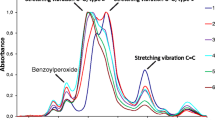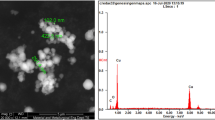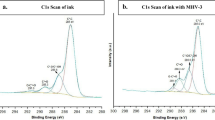Abstract
Glass slides painted with the hydrophobic long-chained polycation N,N-dodecyl,methyl-polyethylenimine (N,N-dodecyl,methyl-PEI) are highly lethal to waterborne influenza A viruses, including not only wild-type human and avian strains but also their neuraminidase mutants resistant to currently used anti-influenza drugs.
Similar content being viewed by others
Avoid common mistakes on your manuscript.
Introduction
Influenza A virus is a ubiquitous and insidious human pathogen infecting yearly tens of millions of people. Particularly troublesome is a threat of yet another (like three such devastating events in the 20th century), virtually inevitable influenza pandemic when a new, likely avian strain of influenza virus, to which humans have no immunity, becomes infective to people (Dowdle 2006).
Influenza viruses are mainly spread from person to person through droplets produced while coughing or sneezing. However, the viruses can also be transmitted when a person touches respiratory droplets settled on an object before transfer to mucosal surfaces (Wright and Webster 2001). This mode of transmitting the infection should be interrupted if the object can inactivate influenza viruses.
Previously, we have developed two successive generations of materials coatings that can kill various microbes on contact (Klibanov 2007) involving either covalent attachment of designed long-chained hydrophobic polycations to surfaces (Lewis and Klibanov 2005) or simply painting surfaces with such polycations (Park et al. 2006). The latter strategy has been found highly effective against pathogenic bacteria and two selected strains of human influenza virus (Haldar et al. 2006). We further expand it herein to demonstrate that surfaces painted with N,N-dodecyl,methyl-polyethylenimine (N,N-dodecyl,methyl-PEI) are also lethal to other influenza viruses, both human and avian, including not only wild-type strains but also those resistant to the commercial anti-influenza drugs, oseltamivir (Roche’s Tamiflu) and zanamivir (GlaxoWellcome’s Relenza).
Material and methods
Materials
N,N-Dodecyl,methyl-PEI was synthesized from commercial branched 750-kDa PEI as described by Park et al. (2006). Organic solvents were from Sigma-Aldrich and glass slides (2.5 × 7.5 cm) from VWR International.
Cells and viruses
Madin–Darby canine kidney (MDCK) cells were obtained from the ATCC. They were grown at 37°C in a humidified-air atmosphere (5% CO2/95% air) in Dulbecco’s modified Eagle’s (DME-Hepes) medium supplemented with 10% heat-inactivated fetal calf serum (GIRGO 614), 100 units/ml penicillin G, 100 μg/ml streptomycin and 2 mM l-glutamine. All influenza A viruses—A/Wuhan/359/95 (H3N2)-like wild type and its oseltamivir-resistant variant carrying Glu119Val mutation in the neuraminidase; A/turkey/Minnesota/833/80 (H4N2) wild type and three neuraminidase inhibitor-resistant variants (Glu119Asp, Glu119Gly and Arg292Lys)—were obtained from the US Centers for Disease Control and Prevention (CDC).
Preparation of painted slides
N,N-Dodecyl,methyl-PEI (50 mg/ml) was dissolved in butanol with vortexing. The commercial glass slides were cut to 2.5 × 2.5 cm pieces and brush-coated with this solution using a cotton swab, followed by air drying; the coating procedure was then repeated.
Preparation of viruses in chicken eggs
A 100-μl aliquot of a 10-fold diluted solution of viruses (CDC samples) was injected into the allantoic fluid of 10-day-old embryonated chicken eggs. The eggs were subsequently incubated at 37°C for 48 h and then at 4°C for 24 h. The allantoic liquid was collected and centrifuged at 1,000g at 4°C for 20 min, followed by passing the supernatant through a 0.45 μm syringe filter (low protein binding) and storing it at −80°C. The virus titer was determined by the plaque assay as described below.
Plaque assay
Confluent MDCK cells in 6-well cell culture plates were washed twice with 5 ml of PBS and infected with 200 μl of a virus solution in PBS at room temperature for 1 h. The solution was then removed by aspiration, and the cells were overlaid with 2 ml of plaque medium (6.9 ml 2× F12 medium, 139 μl of 1% DEAE-dextran, 277 μl of 5% NaHCO3, 139 μl of penicillin (100 units/ml)–streptomycin (100 μg/ml) solution, 122 μl trypsin-EDTA and 4.2 ml 2% Oxoid agar). After incubation for 3 days at 37°C in a humidified-air atmosphere (5% CO2/95% air), the cells were fixed with 1% aqueous formaldehyde for 1 h at room temperature. The agar overlay was removed, and the cells were stained with 0.1% Crystal Violet in 20% methanol for 2 min at room temperature. After removing the excess of the dye by aspiration, the plaques were counted.
Virucidal activity
A glass slide coated with the hydrophobic polycation (or plain in control) was placed into a polystyrene Petri dish (6.0 × 1.5 cm), and then a 10 μl droplet of a 105–107 pfu/ml virus solution was deposited in the centre of the slide. Another, plain glass slide was put on top and pressed to spread the droplet between them. This “sandwiched” system was incubated at room temperature for 5 min. One edge of the top slide was then lifted, and the virus-exposed sides of both slides were thoroughly washed with 0.99 ml of PBS. Plaque assay was subsequently performed to determine the virucidal activity of the washings and of their 2-fold serial dilutions (five times) for the coated slide. A 100–200-fold additional dilution of the washing solution, followed by 2-fold serial dilutions (five times), were made to perform the plaque assay for the uncoated slide (control).
Results and discussion
The main antigenic determinants of influenza A virus are the hemagglutinin (H) and neuraminidase (N) transmembrane glycoproteins giving rise to different subtype-specific strains (Wright and Webster 2001). Based on the antigenicity of these glycoproteins, influenza A viruses cluster into 16 H (H1 to H16) and nine N (N1 to N9) subtypes; five of these (H1, H2, H3, N1 and N2) have caused all human influenza pandemics of the last century (Dowdle 2006). The pandemic influenza viruses of the 1957 “Asian flu” (H2N2) and 1968 “Hong Kong flu” (H3N2) arose from reassortment between human and avian viruses (Kawaoka et al. 1989), whereas the influenza virus which caused the infamous 1918–1919 “Spanish flu” (H1N1) appears to have been derived entirely from the avian source (Taubenberger et al. 2005). Recently, avian influenza attracted world-wide attention when a highly pathogenic strain of the H5N1 subtype not only infected poultry but also transmitted from birds to mammals (cats and swine) including humans. This avian strain caused severe disease and high mortality in people, raising concerns about its pandemic potential (Webster et al. 2006).
In a recent study (Haldar et al. 2006), we found that glass slides painted with N,N-dodecyl,methyl-PEI were highly lethal to the A/WSN/33 (H1N1) (Hiti et al. 1982) and A/Victoria/3/75 (H3N2) (Van Rompuy et al. 1982) strains of human influenza A virus. To test the generality of this observation, herein we broadened the virus repertoire both quantitatively and qualitatively to include two additional influenza A strains, human A/Wuhan/359/95 (H3N2)-like and avian A/turkeyMN/833/80 (H4N2) viruses, as well as their drug-resistant variants (Gubareva et al. 1996; Roberts 2001; Herlocher et al. 2004).
Table 1 depicts the results of a 5 min exposure of the virus solutions either to an uncoated glass slide (a control) or to that painted with N,N-dodecyl,methyl-PEI. While the exposure to the control slide only marginally affects the viral titer after accounting for dilution, the polycation-painted slides completely inactivated the exposed influenza virus reducing its titer over 3,000 times.
Although two neuraminidase inhibitors, oseltamivir and zanamivir, were introduced commercially several years ago to treat influenza A infections (Gubareva et al. 2000), a growing concern with their use is the development of drug-resistant virus strains and their subsequent transmission (Moscona 2005). In fact, several neuraminidase mutants with diminished drug susceptibility have been isolated by using zanamivir in vitro (Glu119Gly, Glu119Ala, Glu119Asp and Arg292Lys) (Gubareva et al. 2002). Furthermore, a mutant (Arg152Lys) influenza strain with a lowered drug sensitivity has been recovered from an immuno-compromised person treated with zanamivir (Gubareva et al. 1998). Likewise, mutations in the neuraminidase glycoprotein (Glu119Val, His274Tyr and Arg292Lys) causing resistance to oseltamivir have arisen both in challenge studies and in patients with naturally acquired infections (Jackson et al. 2000; Gubareva et al. 2001).
Therefore, it was important to ascertain whether N,N-dodecyl,methyl-PEI-coated surfaces can kill drug-resistant strains of influenza A virus in addition to their wild-type parental strains. We started this investigation with a zanamivir-resistant strain of an avian influenza virus A/turkey/MN/833/80, which contains the Glu119Asp neuraminidase mutation. Figure 1A shows that, after 5 min exposure of an aqueous solution of this viral strain to an uncoated glass surface, numerous plaques are clearly visible when MDCK cells were infected with 200 μl of the 200-fold diluted washing solution. In contrast, when 200 μl of even the undiluted washing solution after the analogous exposure to a glass slide painted with the hydrophobic polycation was used to infect MDCK cells, no plaques whatsoever formed in a well (Fig. 1B). Quantification of these data (the first entry in Table 2) reveals at least a 100,000-fold decrease in the viral titer due to the exposure to the polycation-coated surface, as compared to the uncoated one.
The plaque assay was performed with zanamivir-resistant strain of A/turkey/MN/833/80 (Glu119Asp) influenza A virus in MDCK cells. The cells were infected with 200 μl of (a) a 200-fold diluted washing solution from an uncoated control glass slide and (b) the undiluted washings from a N,N-dodecyl,methyl-polyethylenimine-coated glass slide. The images—numerous plaques in a and none in b–were collected after 3 days’ incubation and subsequent staining with Crystal Violet
Similar results were obtained with a different, Glu119Gly neuraminidase mutant of the zanamivir-resistant avian virus, as well as with the Glu119Val neuraminidase mutant of the oseltamivir-resistant human virus (second and third entries in Table 2). Finally, even with a strain of the avian influenza virus, which is resistant to both zanamivir and oseltamivir (the Arg292Lys neuraminidase mutation) (Mishin et al. 2005), a brief exposure to a surface painted with N,N-dodecyl,methyl-PEI results in over a 10,000-fold drop in the viral titer (the last entry in Table 2).
In conclusion, our hydrophobic polycationic coating (Park et al. 2006; Haldar et al. 2006, 2007) exhibits a 100% biocidal efficiency against influenza A virus, presumably by damaging the viral lipid envelope, regardless of whether the virus is of a human or avian origin and even if it is drug-resistant. These features bode well for potential utility of such coatings for preventing the spread of flu.
References
Dowdle WR (2006) Influenza pandemic periodicity, virus recycling, and the art of risk assessment. Emerg Infect Dis 12:34–39
Gubareva LV, Bethell R, Hart GJ, Murti KG, Penn CR, Webster RG (1996) Characterization of mutants of influenza A virus selected with the neuraminidase inhibitor 4-Guanidino-Neu5Ac2en. J Virol 70:1818–1827
Gubareva LV, Matrosovich MN, Brenner MK, Bethell RC, Webster RG (1998) Evidence for zanamivir resistance in an immunocompromised child infected with influenza B virus. J Infect Dis 178:1257–1262
Gubareva LV, Kaiser L, Hayden FG (2000) Influenza virus neuraminidase inhibitors. Lancet 355:827–835
Gubareva LV, Kaiser L, Matrosovich MN, Soo-Hoo Y, Hayden FG (2001) Selection of influenza virus mutations in experimentally infected volunteers treated with oseltamivir. J Infect Dis 183:523–531
Gubareva LV, Webster RG, Hayden FG (2002) Detection of influenza virus resistance to neuraminidase inhibitors by an enzyme inhibition assay. Antiviral Res 53:47–61
Haldar J, An D, Álvarez de Cienfuegos L, Chen J, Klibanov AM (2006) Polymeric coatings that inactivate both influenza virus and pathogenic bacteria. Proc Natl Acad Sci USA 103:17667–17671
Haldar J, Weight AK, Klibanov AM (2007) Preparation, application, and testing of permanently antibacterial and antiviral coatings. Nat Protoc 2 (in press)
Herlocher ML, Truscon R, Elias S, Yen H-L, Roberts NA, Ohmit SE, Monto AS (2004) Influenza viruses resistant to the antiviral drug oseltamivir: transmission studies in ferrets. J Infect Dis 190:1627–1630
Hiti AL, Nayak DP (1982) Complete nucleotide sequence of the neuraminidase gene of human influenza virus A/WSN/33. J Virol 41:730–734
Jackson HC, Roberts N, Wang MZ, Belshe R (2000) Management of influenza; use of new antivirals and resistance perspective. Clin Drug Investig 20:447–454
Kawaoka Y, Krauss S, Webster RG (1989) Avian-to-human transmission of the PB1 gene of influenza A viruses in the 1957 and 1968 pandemics. J Virol 63:4603–4608
Klibanov AM (2007) Permanently microbicidal materials coatings. J Mater Chem 17:2479–2482
Lewis K, Klibanov AM (2005) Surpassing nature: rational design of sterile-surface materials. Trends Biotechnol 23:343–348
Mishin VP, Hayden FG, Gubareva LV (2005) Susceptibilities of antiviral-resistant influenza viruses to novel neuraminidase inhibitors. Antimicrob Agents Chemother 49:4515–4520
Moscona A (2005) Neuraminidase inhibitors for influenza. N Engl J Med 353:1363–1373
Park D, Wang J, Klibanov AM (2006) One-step, painting-like coating procedures to make surfaces highly and permanently bactericidal. Biotechnol Prog 22:584–589
Roberts NA (2001) Treatment of influenza with neuraminidase inhibitors: virological implication. Philos Trans R Soc Lond B 356:1895–1897
Taubenberger JK, Reid AH, Lourens RM, Wang R, Jin G, Fanning TG (2005) Characterization of the 1918 influenza virus polymerase genes. Nature 437:889–893
Van Rompuy L, Jou WM, Huylebroeck D, Friers W (1982) Complete nucleotide sequence of a human influenza neuraminidase gene of subtype N2 (A/Victoria/3/75). J Mol Biol 161:1–11
Webster RG, Peiris M, Chen H, Guan Y (2006) H5N1 outbreaks and enzootic influenza. Emerg Infect Dis 12:3–8
Wright PF, Webster RG (2001) Orthomyxoviruses, fields virology. Lippincott Williams & Wilkins, Philadelphia, pp 1533–1579
Acknowledgements
This work was partly supported by the US Army through the Institute of Solider Nanotechnology under contact DAAD-19-02-D0002 with the Army Research Office and by NIH grant AI56267. We wish to thank Dr. Alexander Klimov (Influenza Division, CDC) for providing wild-type and oseltamivir-resistant strains of influenza A/Wuhan/359/95 (H3N2)-like virus.
Author information
Authors and Affiliations
Corresponding author
Rights and permissions
About this article
Cite this article
Haldar, J., Chen, J., Tumpey, T.M. et al. Hydrophobic polycationic coatings inactivate wild-type and zanamivir- and/or oseltamivir-resistant human and avian influenza viruses. Biotechnol Lett 30, 475–479 (2008). https://doi.org/10.1007/s10529-007-9565-5
Received:
Accepted:
Published:
Issue Date:
DOI: https://doi.org/10.1007/s10529-007-9565-5





